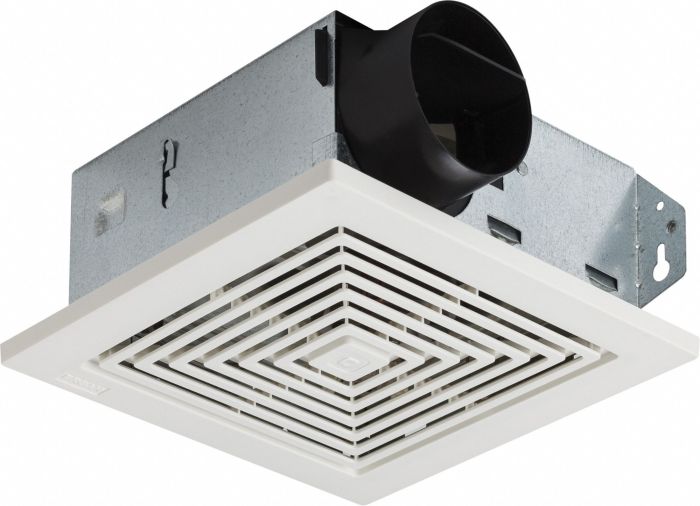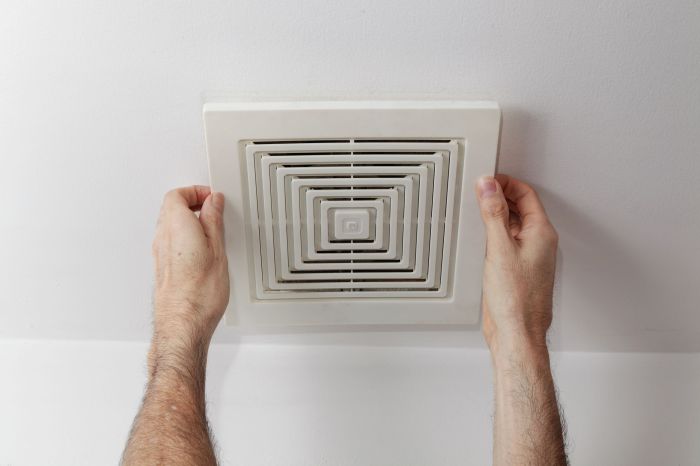In the world of home improvement, space optimization is key. When it comes to bathrooms, finding the right exhaust fan for tight spaces can be a challenge. Enter low profile bathroom exhaust fans, the unsung heroes of ventilation in compact spaces.
These discreet yet effective devices offer a multitude of benefits, making them an ideal choice for small bathrooms, powder rooms, and more. In this comprehensive guide, we’ll delve into the design, performance, and applications of low profile bathroom exhaust fans, providing you with all the information you need to make an informed decision for your space.
From understanding the unique features and advantages of these fans to exploring installation and maintenance considerations, we’ll cover everything you need to know. Whether you’re a seasoned DIY enthusiast or a homeowner looking for expert advice, this guide will equip you with the knowledge and insights to choose the perfect low profile bathroom exhaust fan for your tight space.
Low Profile Bathroom Exhaust Fans for Tight Spaces
Low profile bathroom exhaust fans are designed to fit into tight spaces, making them ideal for small bathrooms or bathrooms with limited ceiling height. These fans are typically less than 3 inches thick, allowing them to be installed in spaces where a standard-sized fan would not fit.
Design Features
Low profile bathroom exhaust fans are designed with several features that make them suitable for small spaces. These features include:
- Compact size: Low profile fans are designed to be as small as possible, allowing them to fit into even the tightest spaces.
- Slim profile: These fans are typically less than 3 inches thick, allowing them to be installed in spaces with limited ceiling height.
- Quiet operation: Low profile fans are designed to operate quietly, making them ideal for small bathrooms where noise can be a concern.
- Energy-efficient: These fans are designed to be energy-efficient, helping to save on energy costs.
Impact of Fan Size and Shape on Airflow and Noise Levels
The size and shape of a low profile bathroom exhaust fan can impact its airflow and noise levels. Larger fans can move more air, but they can also be louder. Smaller fans are quieter, but they may not be able to move as much air.
The shape of the fan can also affect its airflow and noise levels. Fans with curved blades are typically quieter than fans with straight blades.
Performance and Efficiency
Low profile bathroom exhaust fans may have a smaller physical profile, but they are designed to deliver comparable airflow capacity to standard fans. These fans are engineered with efficient impellers and motors that maximize air movement while minimizing energy consumption.
The airflow capacity of a fan is measured in cubic feet per minute (CFM), and it indicates the volume of air the fan can exhaust from the space.
Noise Considerations
Noise levels generated by low profile bathroom exhaust fans can vary depending on the fan model and its design. Some fans utilize advanced noise-dampening technologies, such as rubber mounts or sound-absorbing materials, to minimize noise output. It’s important to consider the noise level when selecting a fan for a tight space, as excessive noise can be distracting or disruptive.
Look for fans with lower sone ratings, which indicate quieter operation.
Selecting the Right Fan Size and CFM Rating
Choosing the right fan size and CFM rating is crucial for optimal performance in tight spaces. A fan that is too small may not be able to adequately ventilate the space, leading to moisture buildup and potential mold growth. Conversely, a fan that is too large may be excessively noisy and may waste energy.
To determine the appropriate CFM rating for your bathroom, consider the size of the room, the number of occupants, and the presence of any moisture-generating fixtures, such as a shower or bathtub.
Installation and Maintenance
Installing low profile bathroom exhaust fans in tight spaces requires careful planning and attention to detail. The compact size of these fans can present unique challenges, such as limited access to wiring and ductwork. However, with the right tools and techniques, installation can be completed successfully.
Installation
Before beginning the installation process, ensure you have the necessary tools, including a screwdriver, drill, and wire cutters. Read the manufacturer’s instructions thoroughly to familiarize yourself with the specific requirements of your chosen fan model.
- Determine the location of the fan and mark the mounting holes. Use a level to ensure the fan will be installed straight.
- Drill pilot holes for the mounting screws and insert the screws to secure the fan housing.
- Connect the fan to the electrical wiring. Make sure the wires are properly secured and insulated.
- Attach the ductwork to the fan outlet and seal the connection with duct tape.
- Turn on the fan and check for proper operation.
Maintenance
Regular maintenance is essential to ensure the efficient operation of your low profile bathroom exhaust fan. Follow these tips to keep your fan running smoothly:
- Clean the fan blades and housing regularly to remove dust and debris.
- Inspect the ductwork for any blockages or leaks and clean as necessary.
- Check the fan motor for any unusual noises or vibrations.
- If the fan fails to operate, check the power supply and wiring connections.
By following these installation and maintenance guidelines, you can ensure that your low profile bathroom exhaust fan provides optimal ventilation for your bathroom space.
Design Ideas and Inspiration
When selecting a low profile bathroom exhaust fan for a tight space, aesthetic considerations are just as important as performance and efficiency. Here are some design ideas and inspiration to help you choose a fan that complements your bathroom’s style and décor:
Consider the overall design of your bathroom. If you have a modern bathroom with clean lines and sleek fixtures, choose a fan with a simple, contemporary design. If you have a more traditional bathroom, choose a fan with a classic or ornate design.
Choosing the Right Fan
- Size and shape: The size and shape of the fan should be proportionate to the size of your bathroom. A small fan will be lost in a large bathroom, while a large fan will overwhelm a small bathroom.
- Color and finish: The color and finish of the fan should complement the colors and finishes of your bathroom fixtures and décor. If you have white fixtures, choose a white fan. If you have brushed nickel fixtures, choose a brushed nickel fan.
- Style: The style of the fan should match the style of your bathroom. If you have a traditional bathroom, choose a fan with a traditional design. If you have a modern bathroom, choose a fan with a modern design.
By following these tips, you can choose a low profile bathroom exhaust fan that is both functional and stylish.
Energy Efficiency and Sustainability
Incorporating eco-friendly practices into home renovations and upgrades is becoming increasingly important. Low profile bathroom exhaust fans contribute to sustainability by offering energy-saving features that reduce energy consumption and minimize environmental impact.
ENERGY STAR certified fans meet strict energy efficiency standards set by the Environmental Protection Agency (EPA). These fans consume less energy while maintaining optimal ventilation performance. By choosing ENERGY STAR certified fans, homeowners can reduce their energy bills and contribute to a greener environment.
Environmental Impact of Bathroom Ventilation
Bathroom ventilation plays a crucial role in maintaining indoor air quality and preventing moisture buildup. However, traditional exhaust fans can contribute to energy waste and carbon emissions. Low profile fans, with their energy-efficient design, reduce energy consumption, thereby reducing greenhouse gas emissions.
Troubleshooting and Repairs
Even the most reliable low profile bathroom exhaust fans can experience issues over time. Here’s how to troubleshoot and repair common problems.
Regular maintenance and cleaning can help prevent issues. If you encounter problems, first check if the fan is turned on and the power is connected. Then, proceed with the troubleshooting steps below.
Fan Not Running
- Check the circuit breaker or fuse box to ensure the fan is receiving power.
- Inspect the fan switch to make sure it is turned on.
- Verify that the fan is properly connected to the power source.
- Check the fan motor for any obstructions or damage.
Fan Running Noisy
- Clean the fan blades and housing to remove any dust or debris.
- Lubricate the fan motor according to the manufacturer’s instructions.
- Check for any loose screws or components that may be causing vibrations.
- Replace the fan motor if it is damaged or worn out.
Fan Not Ventilating Properly
- Check if the fan vent is obstructed by dirt, debris, or closed dampers.
- Ensure that the fan is the correct size for the bathroom space.
- Inspect the ductwork for any leaks or blockages.
- Clean or replace the fan filter if it is clogged.
If you have tried the above troubleshooting steps and the fan is still not functioning properly, it is recommended to call a qualified electrician or HVAC technician for further diagnosis and repairs.
Last Word
As you embark on your bathroom ventilation journey, remember that low profile exhaust fans are not just space-saving solutions but also powerful allies in maintaining a healthy and comfortable indoor environment. Their sleek designs and efficient performance make them an ideal choice for any tight space, ensuring proper ventilation without sacrificing aesthetics or functionality.
Embrace the transformative power of these compact yet mighty fans and enjoy the benefits of a well-ventilated bathroom, no matter how small.



